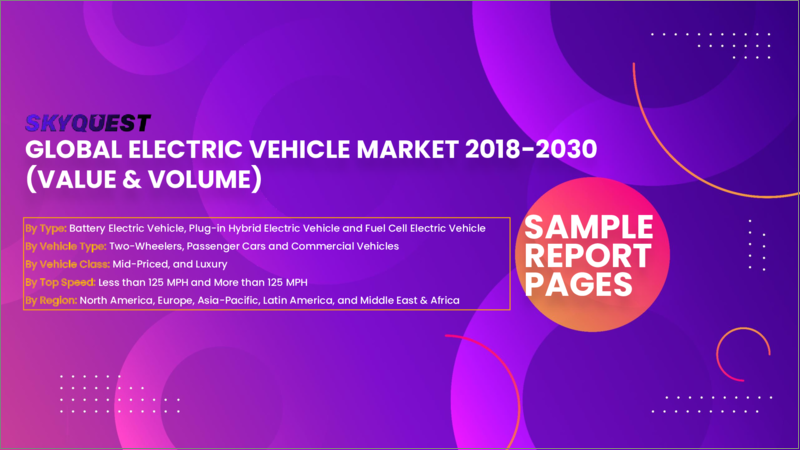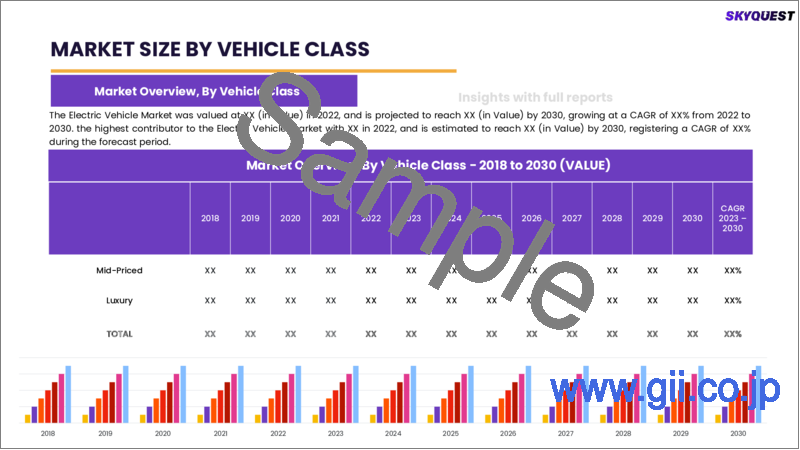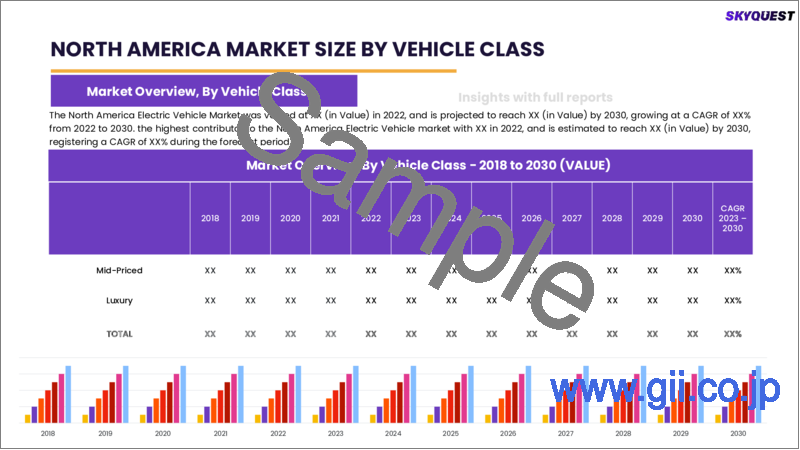|
|
市場調査レポート
商品コード
1360386
電気自動車の世界市場 - 市場規模、シェア、成長分析:タイプ別、車両タイプ別、車両クラス別、最高速度別、車両駆動タイプ別 - 業界予測(2023年~2030年)Global Electric Vehicle Market Size, Share, Growth Analysis, By Type, By Vehicle Type, By Vehicle Class, By Top Speed, By Vehicle Drive Type - Industry Forecast 2023-2030 |
||||||
| 電気自動車の世界市場 - 市場規模、シェア、成長分析:タイプ別、車両タイプ別、車両クラス別、最高速度別、車両駆動タイプ別 - 業界予測(2023年~2030年) |
|
出版日: 2023年09月24日
発行: SkyQuest
ページ情報: 英文 211 Pages
納期: 3~5営業日
|
- 全表示
- 概要
- 目次
電気自動車の市場規模は2021年に1,537億米ドル、2022年には1,935億5,000万米ドルとなりました。同市場は、予測期間(2022年~2028年)に17.30 %のCAGRで拡大し、2030年には6,937億米ドルに達すると予測されています。
世界の電気自動車(EV)市場は、環境意識の高まりと政府のインセンティブに牽引され、大幅な成長を遂げています。EVは排出ガスの削減と運転コストの低減を実現します。大手自動車メーカーはEV技術に投資し、バッテリー効率や充電インフラを強化しています。しかし、航続距離の制限や充電のしやすさといった課題は依然として残っています。技術革新が進むにつれて、EV市場は拡大し、自動車産業を変革し、世界の持続可能な交通システムに貢献すると予想されます。
価格の高騰は、今後数十年で枯渇が予想される再生不可能なガソリンへの欲求の急増に起因しています。ガソリンの需要と供給の変動が価格変動を引き起こします。ガソリンコストを抑制するための世界の努力にもかかわらず、ガソリンコストは長期にわたって高騰しています。ほとんどの国がガソリンの輸入に依存していることから、その消費は経済貿易収支に影響を与えます。石油埋蔵量の有限性と価格の上昇を考慮し、自動車メーカーは代替燃料の選択肢を模索しています。
従来のガソリン、CNG、LPG燃料ステーションに比べ、電気自動車(EV)用の急速充電インフラを設置するために必要な初期投資はかなり高額です。この財政的障壁が、過去10年間、世界各国の政府によるEVの普及を妨げてきました。しかし、技術の進歩がこの制限を緩和し、コスト削減につながると期待されています。多額の出費は、設備コストの上昇や専用の急速充電器の必要性、さらに充電システムを送電網に接続するための変圧器の建設に起因しています。これらの要因は、自動車の排出ガスに関する懸念のために最近勢いを増している、世界の充電ネットワークの急速な拡大を妨げています。
国内の電気自動車産業を促進するため、インド政府は電気自動車(EV)メーカーとユーザーの双方に税制優遇措置と補助金を提供しています。段階的生産計画(PMP)の一環として、政府はEV生産に不可欠な部品に15%の関税を、輸入リチウムイオン電池に10%の関税を課しています。これらのPMP関税の調整案は、2021年4月以降に発効する予定です。
当レポートは、世界の電気自動車市場について調査し、市場の概要とともに、タイプ別、車両タイプ別、車両クラス別、最高速度別、車両駆動タイプ別、地域別の動向、および市場に参入する企業のプロファイルなどを提供しています。
目次
エグゼクティブサマリー
親市場分析
市場規模
- 市場力学
- 促進要因
- 機会
- 抑制要因
- 課題
主要な市場の洞察
- 技術分析
- 価格分析
- サプライチェーン分析
- バリューチェーン分析
- 市場のエコシステム
- IP分析
- 動向分析
- スタートアップ分析
- 原材料分析
- イノベーションマトリックス
- パイプライン製品分析
- マクロ経済指標
- トップ投資分析
- 主な成功要因
- 競合の程度
市場力学と見通し
- 市場力学
- 促進要因
- 機会
- 抑制要因
- 課題
- 規制状況
- ポーター分析
世界の電気自動車市場、タイプ別
- 市場概要
- バッテリー電気自動車
- プラグインハイブリッド電気自動車
- 燃料電池電気自動車
世界の電気自動車市場、車両タイプ別
- 市場概要
- 二輪車
- 乗用車
- 商用車
世界の電気自動車市場、車両クラス別
- 市場概要
- 中価格帯
- 高価格帯
世界の電気自動車市場、最高速度別
- 市場概要
- 時速160マイル未満
- 時速100~125マイル
- 時速125マイル以上
世界の電気自動車市場、車両駆動タイプ別
- 市場概要
- 前輪駆動
- 後輪駆動
- 全輪駆動
世界の電気自動車市場、地域別
- 市場概要
- 北米
- 欧州
- アジア太平洋
- ラテンアメリカ
- 中東・アフリカ
競合情勢
- 主要企業プロファイル
- Tesla
- BYD
- Volkswagen AG
- BMW Group
- Nissan Motors
- Daimler AG
- Energica Motor Company SpA
- Ford Motor Company
- General Motors
- Hero Electric
- Hyundai Motor Company
Electric Vehicle Market was valued at USD 153.7 Billion in 2021, and it is expected to grow from USD 193.55 Billion in 2022 and expected to reach a value of 693.7 by 2030, at a CAGR of 17.30 % over the forecast period (2022-2028).
The global electric vehicle (EV) market has witnessed substantial growth, driven by increasing environmental awareness and government incentives. EVs offer reduced emissions and lower operating costs. Major automakers invest in EV technology, enhancing battery efficiency and charging infrastructure. However, challenges such as range limitations and charging accessibility persist. As innovation continues, the EV market is expected to expand, transforming the automotive industry and contributing to sustainable transportation systems worldwide.
Top-down and bottom-up approaches were used to estimate and validate the size of electric vehicle and to estimate the size of various other dependent submarkets. The research methodology used to estimate the market size includes the following details: The key players in the market were identified through secondary research, and their market shares in the respective regions were determined through primary and secondary research. This entire procedure includes the study of the annual and financial reports of the top market players and extensive interviews for key insights from industry leaders such as CEOs, VPs, directors, and marketing executives. All percentage shares split, and breakdowns were determined by using secondary sources and verified through Primary sources. All possible parameters that affect the markets covered in this research study have been accounted for, viewed in extensive detail, verified through primary research, and analyzed to get the final quantitative and qualitative data.
Drivers
Escalating prices can be attributed to the surging desire for non-renewable petrol, which is anticipated to exhaust in the coming decades. Variations in gasoline demand and supply induce price fluctuations. Despite global efforts to curtail gasoline costs, they have surged over time. Given that most nations depend on petrol imports, its consumption impacts economic trade balance. In light of finite petroleum reserves and increasing prices, automakers are exploring alternative fuel options for their vehicles.
Restraints
In comparison to conventional petrol, CNG, or LPG fuel stations, the initial investment required for establishing a rapid charging infrastructure for electric vehicles (EVs) is considerably higher. This financial barrier has hindered the widespread adoption of EVs by governments globally over the past decade. However, the advancement of technology is expected to mitigate this limitation, leading to cost reductions. The significant expenses stem from elevated equipment costs and the necessity for specialized fast chargers, as well as the construction of transformers to connect the charging system with the grid. These factors have impeded the rapid expansion of charging networks worldwide, which has gained momentum recently due to concerns regarding vehicle emissions.
Market Trends
To promote the domestic electric car industry, the Indian government has provided tax incentives and subsidies to both manufacturers and users of electric vehicles (EVs). As part of the phased manufacturing plan (PMP), the government has imposed a 15% customs duty on components essential for EV production, along with a 10% tariff on imported lithium-ion cells. These proposed adjustments to the PMP duties are anticipated to take effect from April 2021 onwards.
Table of Contents
Executive Summary
- Market Overview
- Wheel of Fortune
- Research Methodology
- Information Procurement
- Secondary & Primary Data Sources
- Market Size Estimation
- Market Assumptions & Limitations
Parent Market Analysis
- Market Overview
- Market Size
- Market Dynamics
- Drivers
- Opportunities
- Restraints
- Challenges
- Key Market Insights
- Technology Analysis
- Pricing Analysis
- Supply Chain Analysis
- Value Chain Analysis
- Ecosystem of the Market
- IP Analysis
- Trade Analysis
- Startup Analysis
- Raw Material Analysis
- Innovation Matrix
- Pipeline Product Analysis
- Macroeconomic Indicators
- Top Investment Analysis
- Key Success Factor
- Degree of Competition
- Market Dynamics & Outlook
- Market Dynamics
- Drivers
- Opportunities
- Restraints
- Challenges
- Regulatory Landscape
- Porters Analysis
- Competitive rivalry
- Threat of Substitute Products
- Bargaining Power of Buyers
- Threat of New Entrants
- Bargaining Power of Suppliers
- Skyquest Special Insights on Future Disruptions
- Political Impact
- Economic Impact
- Social Impact
- Technical Impact
- Environmental Impact
- Legal Impact
Global Electric Vehicle Market by Type
- Market Overview
- Battery Electric Vehicle
- Plug-in Hybrid Electric Vehicle
- Fuel Cell Electric Vehicle
- Global Electric Vehicle Market by Vehicle Type
- Market Overview
- Two-Wheelers
- Passenger Cars
- Commercial Vehicles
- Global Electric Vehicle Market by Vehicle Class
- Market Overview
- Mid-Priced
- Luxury
- Global Electric Vehicle Market by Top Speed
- Market Overview
- Less Than 100 MPH
- 100 to 125 MPH
- More Than 125 MPH
- Global Electric Vehicle Market by Vehicle Drive Type
- Market Overview
- Front Wheel Drive
- Rear Wheel Drive
- All Wheel Drive
- Global Electric Vehicle Market Size by Region
- Market Overview
- North America
- USA
- Canada
- Europe
- Germany
- Spain
- France
- UK
- Rest of Europe
- Asia Pacific
- China
- India
- Japan
- South Korea
- Rest of Asia-Pacific
- Latin America
- Brazil
- Rest of Latin America
- Middle East & Africa (MEA)
- GCC Countries
- South Africa
- Rest of MEA
- Competitive Landscape
- Top 5 Player Comparison
- Market Positioning of Key Players, 2021
- Strategies Adopted by Key Market Players
- Top Winning Strategies
- By Development
- By Company
- By Year
- Recent Activities in the Market
- Key Companies Market Share (%), 2021
- Key Company Profiles
- Tesla (US)
- Company Overview
- Business Segment Overview
- Financial Updates
- Key Developments
- BYD (China)
- Company Overview
- Business Segment Overview
- Financial Updates
- Key Developments
- Volkswagen AG (Germany)
- Company Overview
- Business Segment Overview
- Financial Updates
- Key Developments
- BMW Group (Germany)
- Company Overview
- Business Segment Overview
- Financial Updates
- Key Developments
- Nissan Motors (Japan)
- Company Overview
- Business Segment Overview
- Financial Updates
- Key Developments
- Daimler AG(Germany)
- Company Overview
- Business Segment Overview
- Financial Updates
- Key Developments
- Energica Motor Company S.p.A. (Italy)
- Company Overview
- Business Segment Overview
- Financial Updates
- Key Developments
- Ford Motor Company (US)
- Company Overview
- Business Segment Overview
- Financial Updates
- Key Developments
- General Motors (US)
- Company Overview
- Business Segment Overview
- Financial Updates
- Key Developments
- Hero Electric (India)
- Company Overview
- Business Segment Overview
- Financial Updates
- Key Developments
- Hyundai Motor Company (South Korea)
- Company Overview
- Business Segment Overview
- Financial Updates
- Key Developments




